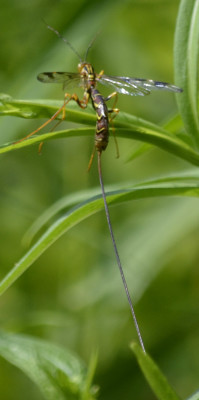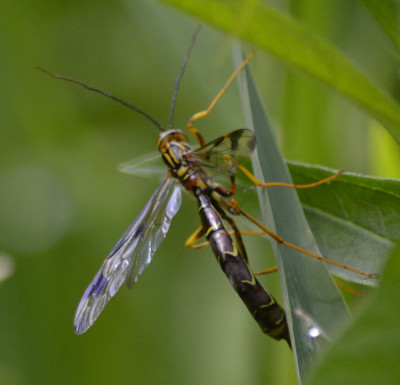While watching a House Wren hunting among the tall grasses and rushes in an almost dry marsh in Mississauga, I watched as another odd flying predator wobbled into view. This one was some kind of insect. It looked like a wasp, but had an amazingly long tail.
I would guess the tail along was about 4 inches long and thread-thin. It was much longer than the insect’s body. The legs were also unusually long. Given the fairly small wings were located way up on the “shoulders” of the creature, it was not very aerodynamic. In fact, it flew very badly. The long tail also seemed to cause trouble as it bumped into the vegetation.
I took a few photos although it was a bit too far away to focus on clearly. As I watched, it rose up and moved a few grasses over, then settled again. This repeated several times. I couldn’t tell if it was trying to feed, trying to catch something or trying to lay eggs. I wasn’t even sure exactly what it was.
When I was home, I searched the internet for wasps with long tails. It didn’t take long to find my insect: it was a Giant Ichneumon Wasp. The helpful people at BugGuide.net confirmed it was a Megarhyssa macrurus.
Why Does This Wasp Have an Amazingly Long Tail?
The “tail” that makes it so awkward for a female Giant Ichneumon Wasp to fly is actually an ovipositor. It’s used to lay her eggs.
Like a woodpecker, this wasp drills through dead tree trunks to reach the grub-like larvae living deep inside. Unlike a woodpecker, she doesn’t eat them herself: instead she lays her eggs on them and the baby Ichneumons eat them. She also doesn’t drill a hole in the wood with her bill or mouth, instead she drills with the long pipe-like ovipositor!
There are some videos and an interesting written summary of how the Giant Ichneumon Wasp drills down through a dead tree trunk to reach an insect larvae and lay an egg on it at the Nature Documentaries website.
It’s fascinating to think anything as long and delicate looking as this wasp’s ovipositor can actually work its way through wood!
According to the Animal Diversity website of the University of Michigan the wasp lays one egg directly on one larvae of a Pigeon Horntail. To do that she must hear the larvae in the dead tree, then drill down with her ovipositor to reach the horntail. The site says it is not known exactly how the female detects the presence of the larvae: it may hear it or smell it. They also say it can take an hour for her to successfully drill, lay her egg, and pull out, and that she is vulnerable to predators during that time.
What Do These Awkward Wasps Eat?
As adults, Giant Ichneumon Wasps don’t seem to eat much. There are some photos though of one of them apparently drinking juice from a grape.
In the larval stage, one wasp feeds externally on one Pigeon Horntail larvae, eventually killing it.
Pigeon Horntails, Tremex columba, are another type of wasp. They are a wood wasp whose grub stage usually lives in dead or dying trees. Trees they live in include beeches, elms, maples, oaks, poplars and apples, according to BugGuide.net. All of those trees grow along the Credit River valley in Mississauga.
Can Ichneumon Wasps Sting?
According to Lloyd Eighme, retired entomologist on the Washington State University Skagit County website, the wasps probably can sting but are not known to do so. The author doubts that most of them could get their sting to penetrate your skin.
The Texas A&M AgriLife Extension website says they could sting if improperly handled but are, in the words of the Hitchhiker’s Guide to the Galaxy, “mostly harmless.”
Other websites say they don’t sting. They are probably correct because they are not saying that they can’t sting only that they generally don’t.
I did not read any comments on any websites from someone claiming to have been stung by one.
Frankly the female flew so awkwardly I can’t imagine why you wouldn’t be able to swat it out of your way before it could even try to sting you, if you were worried. I certainly didn’t feel nervous approaching it as closely as the path would permit.
Keep Your Eyes Open for Strange Insects
I spotted this odd character while waiting for a House Wren to return to its nest with food for its chicks. Had I not been waiting I might never have seen this Ichneumon when it wobbled into view. It served as a good reminder that I need to stay alert and look for new animals on my rambles.
Related Reading
Join In
Have you ever seen such a long-tailed wasp? Was it trying to lay eggs? Please share your sighting with a comment.



